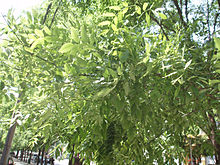| Styphnolobium | |
|---|---|

| |
| Styphnolobium japonicum foliage | |
| Scientific classification | |
| Kingdom: | Plantae |
| Clade: | Tracheophytes |
| Clade: | Angiosperms |
| Clade: | Eudicots |
| Clade: | Rosids |
| Order: | Fabales |
| Family: | Fabaceae |
| Subfamily: | Faboideae |
| Clade: | Cladrastis clade |
| Genus: | Styphnolobium Schott (1829) |
| Type species | |
| Styphnolobium japonicum (L.) Schott
| |
| Species[1] | |
|
9; see text | |
| Synonyms | |
| |
Styphnolobium is a genus of flowering plants in the pea family, Fabaceae. It includes nine species of small trees and shrubs native to China and to the Americas, from the southern United States to Colombia.[1] It belongs to subfamily Faboideae, and was formerly included within a broader interpretation of the genus Sophora. It was recently assigned to the unranked, monophyletic Cladrastis clade.[2][3][4] They differ from the genus Calia (mescalbeans) in having deciduous leaves and flowers in axillary, not terminal, racemes. The leaves are pinnate, with 9–21 leaflets, and the flowers in pendulous racemes similar to those of the black locust. Necklacepod is a common name for plants in this genus.[5]
- ^ a b Styphnolobium Schott. Plants of the World Online. Retrieved 21 September 2023.
- ^ Cardoso D, Pennington RT, de Queiroz LP, Boatwright JS, Van Wyk B-E, Wojciechowski MF, Lavin M (2013). "Reconstructing the deep-branching relationships of the papilionoid legumes" (PDF). S Afr J Bot. 89: 58–75. doi:10.1016/j.sajb.2013.05.001.
- ^ Cardoso D, de Queiroz LP, Pennington RT, de Lima HC, Fonty É, Wojciechowski MF, Lavin M (2012). "Revisiting the phylogeny of papilionoid legumes: new insights from comprehensively sampled early-branching lineages". Am J Bot. 99 (12): 1991–2013. doi:10.3732/ajb.1200380. PMID 23221500.
- ^ Wojciechowski MF (2013). "The origin and phylogenetic relationships of the Californian chaparral 'paleoendemic' Pickeringia (Leguminosae)". Syst Bot. 38 (1): 132–142. doi:10.1600/036364413X662024. S2CID 86331839.
- ^ USDA, NRCS (n.d.). "Styphnolobium". The PLANTS Database (plants.usda.gov). Greensboro, North Carolina: National Plant Data Team. Retrieved 4 December 2015.